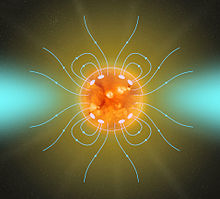- Magnetic braking
-
Magnetic braking is a theory explaining the loss of solar angular momentum due to material getting captured by the solar magnetic field and thrown out at great distance from the surface of the Sun.
Contents
The problem
The currently accepted theory of the solar system's evolution states that the Solar System originates from a contracting gas cloud. As the cloud contracts the angular momentum L must be conserved, this is in accordance with the angular momentum of the major planets, but when the planets' angular momentum are compared to the Sun's own, the Sun has less than 1% of its supposed angular momentum. In other words, the Sun has slowed down its spin while the planets have not.
The idea behind magnetic braking
Even though material falling in towards the Sun has its angular momentum conserved and will thus add to the spin, The ionized material captured by the magnetic field lines will rotate with the Sun as a solid body. If material escapes from the Sun due to solar wind, i.e., driven out by thermal pressure, the highly ionized material will get captured by the field lines and rotate with the same angular velocity as the Sun even though its carried far away from the Sun's surface and should in principle have its rotation governed by "normal" celestial mechanics. This effect of carrying mass into a great distance and throwing it away robs the Sun of its spin. A likewise analog effect is used in slowing the spin of a rotating satellite, here two wires spool out weights into a distance slowing the satellites spin, then the wires are cut, letting the weights escape into space and permanently robbing the spacecraft of its angular momentum.
Theory behind magnetic braking
As ionized material follows the Sun's magnetic field lines, due to the effect of the field lines being frozen in the plasma, the charged particles feel a force
 of the magnitude:
of the magnitude:where q is the charge, v is the velocity and
 is the magnetic field vector. This bending action forces the particles to "corkscrew" around the magnetic field lines while held in place by an "magnetic pressure"PB, or "energy density", while rotating together with the Sun as a solid body:
is the magnetic field vector. This bending action forces the particles to "corkscrew" around the magnetic field lines while held in place by an "magnetic pressure"PB, or "energy density", while rotating together with the Sun as a solid body:Since magnetic field strength decreases with the cube of the distance there will be a place where the kinetic gas pressure Pg of the ionized gas is great enough to break away from the field lines:
- Pg = nmv2
where n is the number of particles, m is the mass of the individual particle and v is the radial velocity away form the Sun, or the speed of the solar wind.
The magnetic field strength as a function of radius can be approximated as:
The critical distance where the material will break away from the filed lines can then be calculated as the distance where the kinetic pressure and the magnetic pressure are equal, i.e.:
If the solar mass loss is omni-directional the mass loss then
 , plugging this into the above equation an isolating the critical radius it follows that:
, plugging this into the above equation an isolating the critical radius it follows that:Present day value
Currently it is estimated that:
- The mass loss of the Sun is about

- The solar wind speed is

- The dipole field is

This leads to a critical radius of
 . This means that the ionized plasma will rotate together with the Sun as a solid body until it reaches an distance of nearly 3½ the radius of the Sun, from there the material will break off and stop affecting the Sun.
. This means that the ionized plasma will rotate together with the Sun as a solid body until it reaches an distance of nearly 3½ the radius of the Sun, from there the material will break off and stop affecting the Sun.The amount of solar mass needed to be thrown out along the field lines to make the Sun completely stop the rotation can then be calculated using the specific angular momentum:
About 1/10 of the solar mass should thus have be lost by now due to this effect, but if the present mass loss rate was stable throughout the Sun's "life" only about 0.01% of the Sun's original mass would have been lost. This indicates that either the Sun's mass loss must have been higher in the past or that the Sun's magnetic field has been much stronger.
See also
Categories:- Conservation laws
- Fundamental physics concepts
- Physical quantities
- Rotation
- Rotational symmetry
Wikimedia Foundation. 2010.








![r_c=\sqrt[4]{\frac{2\pi D_\cdot ^2}{\mu_0 v (dM/dt)}}](5/64557834f560efc07660998e02bfca74.png)
